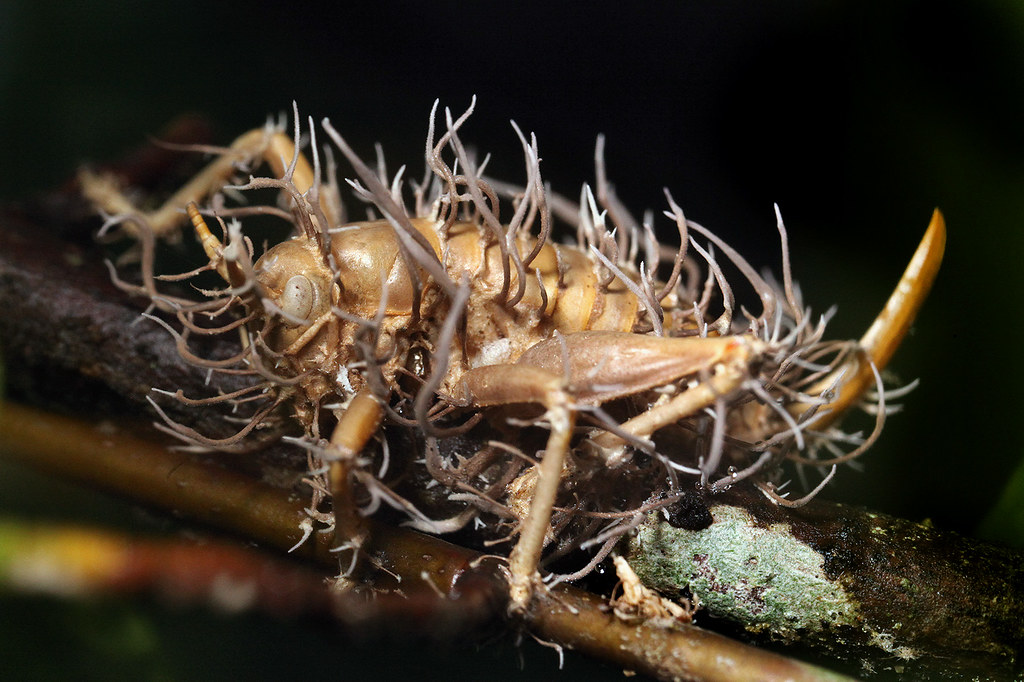#entomopathogenic fungus
Photo

Weevil infected with entomopathogenic fungus
Photographed in Peru by Frank Deschandol // Instagram
Shared with permission; do not remove credit or re-post!
#animals#curators on tumblr#insects#bugs#beetle#weevil#entomopathogenic fungus#parasitic fungus#cordyceps#dead bugs#Ophiocordyceps curculionum#Ophiocordyceps#one nice bug
3K notes
·
View notes
Photo
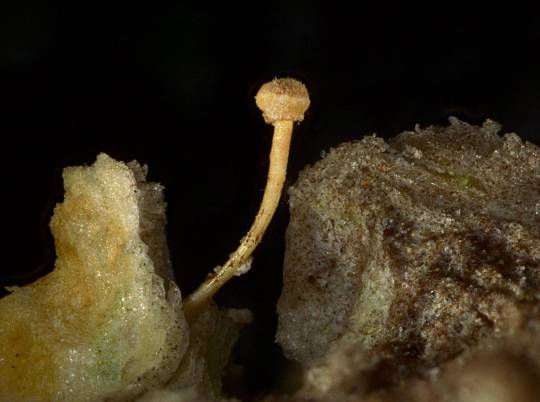
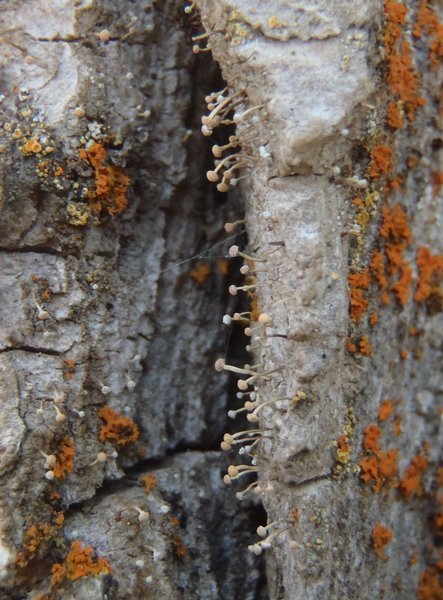


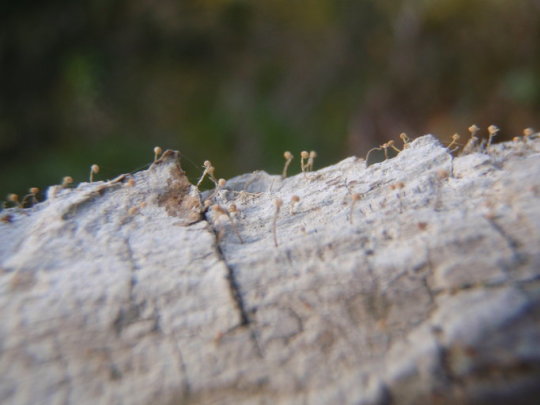




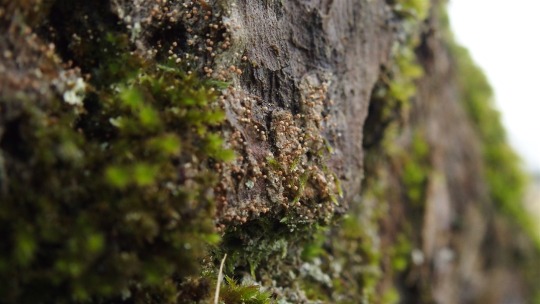
Sclerophora amabilis
Collared glass-whiskers lichen
OMG have you ever seen anything cuter??? I doubt it. Go on . . . I’ll wait . . . nothing, right? That’s what I thought.
images: source | source | source | source
#lichen#lichens#lichenology#lichenologist#lichenized fungus#entomopathogenic fungus#fungi#mycology#ecology#biology#botany#bryology#systematics#taxonomy#life science#environmental science#natural science#nature#naturalist#beautiful nature#weird nature#the natural world#Sclerophora amabilis#Sclerophora#I'm lichen it#lichen a day#daily lichen post#lichen subscribe#I love lichens#lichens are so good
101 notes
·
View notes
Video
Frozen Zombie by John Hallmén
Via Flickr:
Formica sp. Size: 5-6 mm I've shown these ants killed by a "mind-manipulating" parasitic fungus multiple times before in my stream but this shows one where the fungus has matured further. Stacked from 43 natural light exposures in Zerene Stacker. Shot as the morning sun was melting the ice crystals away (see below). Optics: Bellows mounted Carl Zeiss Luminar 63/4.5. View larger!
#insect#macro#ant#hymenoptera#formica#entomopathogenic fungus#Canon 5DmkII#Nikon PB-6 bellows#Carl Zeiss Luminar 63mm f4.5#Natural light#Zerene stacker#nrm#flickr#john hallmen#photographer#nature
6 notes
·
View notes
Note
have you talked about entomopathogenic fungi here? i think they're extremely cool! huge fan of Massospora cicadina, personally :]
i actually have not, yet !! let me know what you'd like me to say about it. i'll work on a little post with info about it & some examples, though :-) it's such an interesting concept.
massospora cicadina is a fascinating example of this & definitely something worth looking into.
i could even.. do a FOTD.. wink wonk..
i love when people share their thoughts with me on any sort of fungi topics, so i'm glad you sent in an ask !!
#• askbox replies: •#(ask : copper-sands)#[massospora cicadina]#||#entomopathogenic#fungi#fungus#mushroom#mycology#mushrooms#cottagecore#nature#massospora cicadina
5 notes
·
View notes
Note
found this critter (orbweaver?) dead, and there's this fuzzy white stuff on the abdomen? is it mold? I'm so curious as to what happened and why it only happened in the abdomen, thanks!
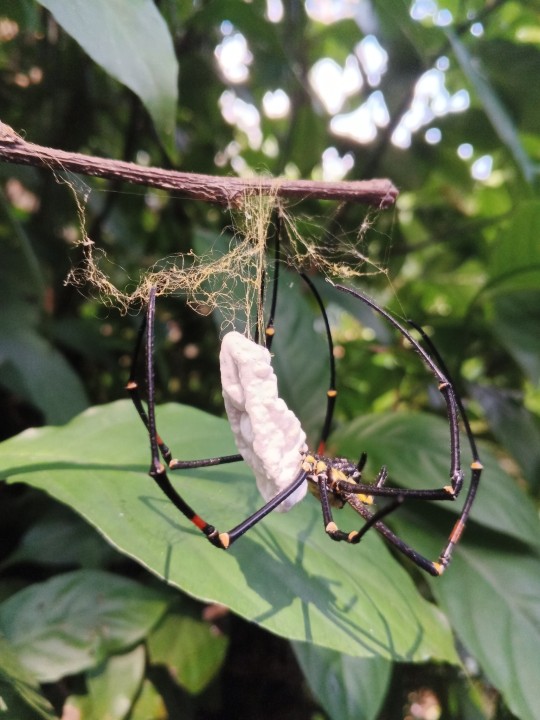
probably an entomopathogenic fungus. I ran across the genus Gilbellula in a very cursory search, but this is a fairly well-observed phenomenon even if most sightings don’t identify the pathogen
261 notes
·
View notes
Text

Funguary Feb 28 - Cryptic Icing Sugar Fungus - Beauveria bassiana
The group of entomopathogenic fungi known as icing sugar fungus also affect True Fae. In this case, it is one of the few ways that the fae can become undead.
#original art#funguary#funguary2024#funguary 2024#mushroom#fungus#fungi#parasite#cryptic#icing sugar#icing sugar fungus#beauveria bassiana#undead
22 notes
·
View notes
Text
Get Today's Best Metarhizium Anisopliae biopesticide at Peptech Biosciences Ltd
Metarhizium Anisopliae stands out as a distinctive biological insecticide. This entomopathogenic fungus induces muscardine disease in a variety of insects such as bugs, weevils, and hoppers. Upon contact with a host’s cuticle, M. anisopliae spores rapidly grow and multiply within the insect. Once inside, the fungus releases toxins, initiating protein degradation. The insect succumbs to a combination of chemical, mechanical, water loss, and nutrient loss effects. The speed of the insect’s demise hinges on factors like the spore count, the insect’s age, susceptibility, and prevailing environmental conditions.
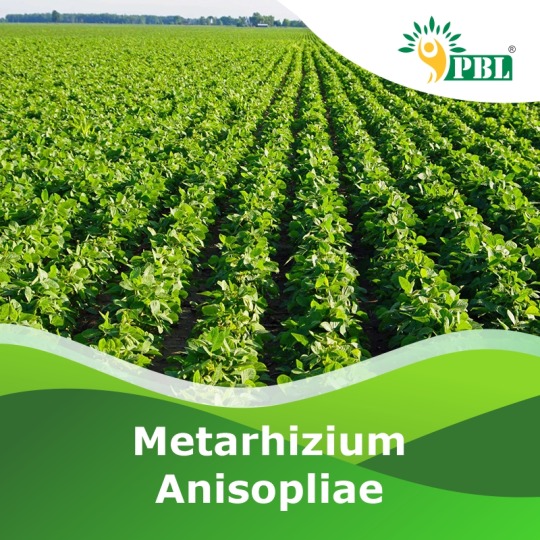
0 notes
Text
Metarhizium anisopliae: Nature's Precision in Eco-Friendly Pest Control
Metarhizium anisopliae is a naturally occurring fungus widely used as a biopesticide for insect pest control. As an entomopathogenic fungus, it infects a broad spectrum of pests, offering an eco-friendly alternative to chemical pesticides. Its mode of action involves penetrating the insect cuticle, releasing toxins, and causing pest mortality. This biopesticide is environmentally safe, compatible with Integrated Pest Management (IPM) practices, and available in various commercial formulations for soil or foliar application. Ongoing research continues to optimize its effectiveness and explore new applications. For cutting-edge biopesticide solutions, explore Peptech’s innovative products at Peptech’s Website.

0 notes
Text
BENEFITS OF METARHIZIUM ANISOPLIAE | MANUFACTURER & EXPORTER - PEPTECH BIO
Metarhizium anisopliae, a naturally occurring entomopathogenic fungus, offers numerous advantages for sustainable and eco-friendly agriculture. Acting as a biological pest control agent, it provides targeted specificity against certain insect pests while preserving the environment. Its benefits include:
Biological Pest Control: Natural control agent against insect pests.
Targeted Specificity: Selectively targets pests without harming beneficial organisms.
Sustainable Agriculture: Aligns with principles of eco-friendly and balanced farming.
Environmentally Friendly: Minimizes harm to non-target organisms and ecosystems.

0 notes
Text

Beauveria Bassiana Biopesticide
Beauveria Bassiana is a unique biopesticide. This unique biopesticide harnesses the ability of naturally occurring fungi dwelling in the soil. Beauveria bassiana, an entomopathogenic fungus, initiates a white muscadine disease, targeting a spectrum of sap-sucking pests including aphids, thrips, and whiteflies. Upon contact with the target insect, its spores promptly germinate, infiltrating via cuticle spiracles. The fungus multiplies internally, releasing toxins and sapping nutrients, leading to the pest's demise. This potent biopesticide thrives in warm, humid conditions, with effectiveness contingent on spore count, insect age, susceptibility, and environment. Beauveria bassiana presents an environmentally friendly solution, aligning with sustainable practices and exemplifying the synergy between nature and agriculture. Elevate your pest management strategy with the exceptional Beauveria bassiana biopesticide.
#beauveria bassiana#beauveria bassiana biopesticide#beauveria bassiana bioinsecticide#beauveria bassiana dose#beauveria bassiana manufacturer#beauveria bassiana dose per acre
0 notes
Photo
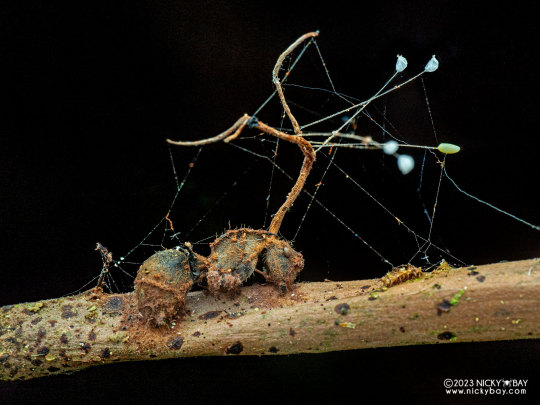
Ant infected with cordyceps fungus featuring lacewing eggs that were deposited on the fungal body - all hatched except one.
Photographed in Singapore by Nicky Bay // Website // Facebook
Shared with permission; do not remove credit or re-post!
Bonus cordyceps photos:
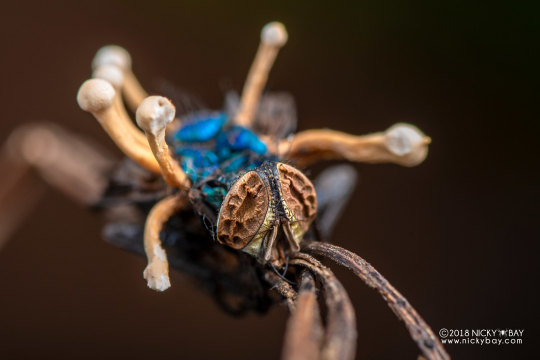
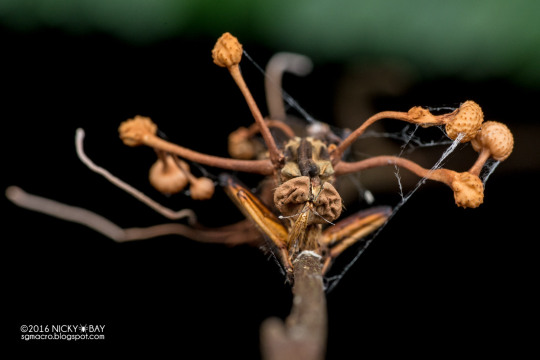





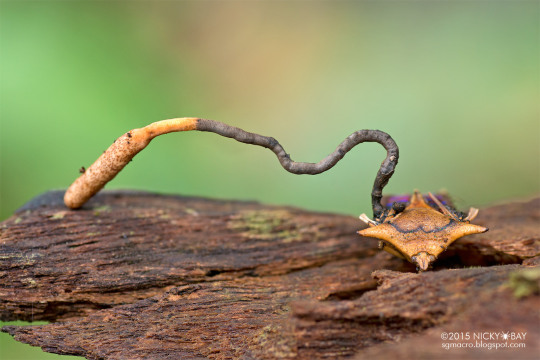

#animals#curators on tumblr#insects#bugs#arachnids#fungus#parasite#parasitism#parasitic fungus#entomopathogenic fungus#cordyceps#dead bugs#spider#true bugs#fly#wasp#ant#one nice bug#but dead this time#:(
486 notes
·
View notes
Text
Les champignons entomopathogènes dans le biocontrôle des moustiques : des progrès récents
See on Scoop.it - EntomoNews
Recent Advancements in Pathogenic Mechanisms, Applications and Strategies for Entomopathogenic Fungi in Mosquito Biocontrol
by Yujie Qin
Journal of Fungi
Published: 13 July 2023
[Image] Two invasion pathways of EPF in mosquitoes: cuticle and digestive tract routes. EPF infect mosquito adults, eggs, and pupae through contact with the cuticle. Larvae can be infected through both the cuticle and digestive tract routes. Fungal conidia attach to the cuticle and germinate to form germ tubes, which either penetrate the cuticle directly or develop appressoria at the end of the germ tubes to penetrate the cuticle. Once the cuticle is breached, hyphal bodies rapidly developed in the hemolymph of adult. In eggs, the growth of hyphal bodies inside can cause incomplete embryogenesis or spontaneous premature eclosion. Toxic metabolites can disrupt the balance of microorganisms in the midgut and accelerate mosquito mortality. In pupae, cuticle infection can lead to death or accelerated molting. In larvae, similar to adults, conidia can infect through the cuticle and enter the hemolymph. Additionally, conidia can be ingested and grow within the digestive tract. The fungus can penetrate the peritrophic membrane of the midgut to enter the hemolymph.
-------
NDÉ
Traduction
Les maladies fongiques sont très répandues parmi les insectes et jouent un rôle crucial dans la régulation naturelle des populations d'insectes. Les moustiques, connus comme vecteurs de nombreuses maladies infectieuses, constituent une menace importante pour la santé humaine.
Les champignons entomopathogènes (EPF, pour Entomopathogenic fungi) sont apparus comme des agents alternatifs très prometteurs aux insecticides chimiques pour lutter contre les moustiques à tous les stades de leur cycle de vie, en raison de leur voie d'infection unique par contact direct avec la cuticule de l'insecte.
Ces dernières années, des progrès significatifs ont été réalisés dans la compréhension des voies d'infection et des mécanismes pathogènes des EPF contre les moustiques. Diverses stratégies impliquant l'utilisation de l'EPF seul ou en combinaison avec d'autres approches ont été employées pour cibler les moustiques à différents stades de développement. En outre, l'application des technologies génétiques aux champignons a ouvert de nouvelles voies pour améliorer l'efficacité anti-moustique des EPF.
Cette étude présente un résumé complet des avancées récentes dans notre compréhension des mécanismes pathogènes des EPF, de leurs applications dans la gestion des moustiques, de la combinaison des EPF avec d'autres approches et de l'utilisation des technologies transgéniques. Les problèmes de biosécurité associés à leur utilisation et aux approches correspondantes sont également abordés.
Les progrès récents suggèrent que les EPF ont le potentiel de servir d'outil biologique futur pour contrôler les moustiques vecteurs.
0 notes
Video
fungus infected Carolina leaf-roller by kim fleming
Via Flickr:
Camptonotus carolinensis infected with ophiocordyceps in its asexual (Hirsutella) phase. Same insect last November.
#entomopathogenic#fungus#carolina leaf-roller#orthoptera#ensifera#tettigoniidea#gryllacrididae#camptonotus#Camptonotus.carolinensis#ophiocordyceps#asexual#hirsutella#beech#flickr#kim fleming#photographer#nature
24 notes
·
View notes
Text
freaky fungi fact : entomopathogenic fungi !!
entomopathogenic fungi are fungi that can kill or seriously disable insects.
this group of fungi lives in the soil & infects insects by penetrating their bodies to feed on them, & eventually kill them. they are sorted into five divisions (ascomycota, zygomycota, deuteromycota, oomycota & chytridiomycota), each with their own properties.
they have a big impact on insect population dynamics in soil.
there are currently over 800 different entomopathogenic fungi that have been identified.
below the cut are some images of insects that have been infected. CW for animal death + bugs / other critters + just general disturbing imagery.
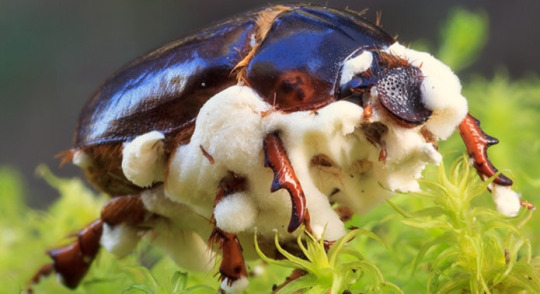
a beetle parasitised by an unnamed entomopathogenic fungus. [source]

a cicada parasitised by the massospora cicadina fungus. [source]

a spider parasitised by an unnamed entomopathogenic fungus. [source]
[the lovely user who asked me to talk about this : source<3]
#thank you to tumblr user copper-sands for suggesting i talk about this<3#i learn so much every day.#|#• finn's freaky fungi fact ^^ •#[massospora cicadina]#||#fungi#fungus#mushroom#mycology#mushrooms#earth#nature#forestcore#cottagecore#foraging#cw animal death#cw bugs#bugs#insects#animal death#parasites#massospora cicadina#entomopathogenic#fungal parasites#insect#critters#science#biology#ecology
106 notes
·
View notes
Text
The Mighty Metarhizium Anisopliae: Unleashing Nature's Biocontrol Agent
Metarhizium anisopliae is a species of entomopathogenic fungus that is widely used in agriculture and pest control. Here are some of the key uses of Metarhizium anisopliae.

Biological Pest Control
Metarhizium anisopliae is primarily used as a biocontrol agent for managing insect pests. The fungus infects and kills a wide range of insects and other arthropods, including beetles, termites, grasshoppers, and mosquitoes. It can be applied as a spray, dust, or granule, targeting specific pest species while minimizing harm to non-target organisms.
Agricultural Applications
Metarhizium anisopliae is employed in agriculture to combat pests that damage crops. By using this fungal biopesticide, farmers can reduce reliance on chemical insecticides and promote sustainable pest management practices, and the killing of nematodes like Paecilomyces Lilacinus.
Vector Control
The fungus is also used to control disease-transmitting vectors such as mosquitoes and ticks. Metarhizium anisopliae can be applied in mosquito breeding sites or as a barrier treatment to prevent mosquito populations from spreading diseases like malaria, dengue, Zika, and others. It offers an environmentally friendly alternative to chemical insecticides.
Forest Pest Mangement
Forests face various insect pests that can cause significant damage to trees. Metarhizium anisopliae has been used to control pests like bark beetles, leaf-feeding caterpillars, and wood borers. By introducing the fungus into affected areas, it can help manage pest populations and protect forest resources.
Veterinary Applications
Metarhizium anisopliae is utilized in veterinary medicine to control ectoparasites infesting livestock and companion animals. It can be used to manage pests such as fleas, ticks, mites, and lice. The application of the fungus as a biocontrol agent reduces the reliance on chemical pesticides in animal husbandry.
Environmental Applications
Apart from its role in pest control, Metarhizium anisopliae has potential applications in environmental remediation. The fungus has been studied for its ability to degrade pollutants and contaminants, including organic pollutants in soil and water. This property opens up possibilities for using the fungus in bioremediation processes.
0 notes
Text
Vault 22
Vault 22 was an experiment where the vault ran of plants, this was a bad idea, Beauveria mordicana was originally an entomopathogenic fungus designed for pest control this was a good idea to start with as it infects the host and kills it once dead the fungus control the hosts body and infects anything it can, this is the downfall of the vault as the spores of the fungus spreaded threw the vault infecting all the dwellers
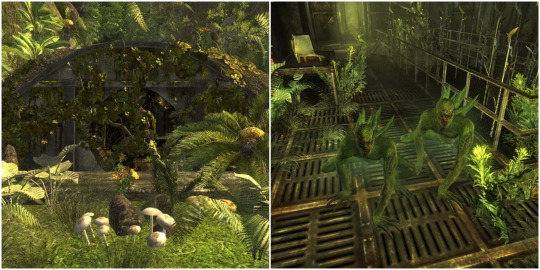

1 note
·
View note
